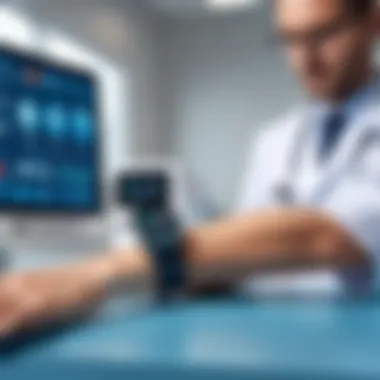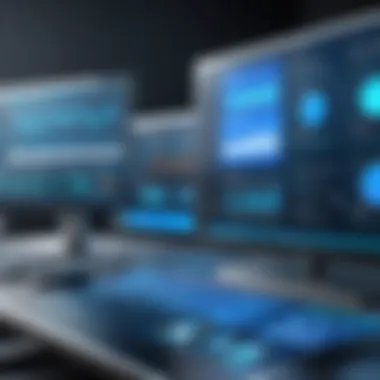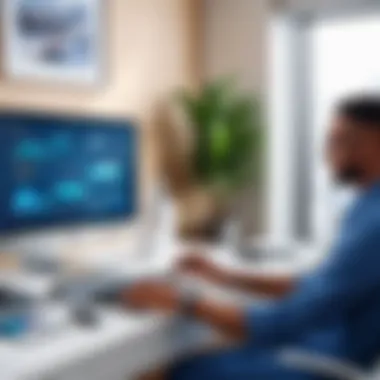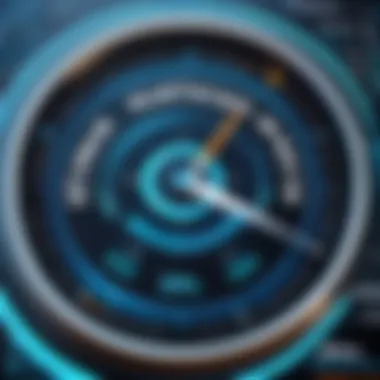Navigating Remote Patient Monitoring Under Medicare


Intro
Remote Patient Monitoring (RPM) is becoming an integral part of the healthcare system, especially with the advent of new technology in patient care. As healthcare evolves, so does the way medical professionals track and manage patient health remotely. This shift not only enhances patient outcomes but also integrates into existing frameworks, particularly Medicare, which has historically set the pace for healthcare reforms in the United States. Understanding the interplay between RPM and Medicare frameworks is crucial for stakeholders in healthcare, including providers and administrators.
This article aims to explore the complexities of this intersection, focusing on technological functionalities, and regulatory aspects of RPM under Medicare. By examining how RPM reshapes patient care dynamics, we will illuminate the benefits and challenges that healthcare professionals face while navigating this landscape.
Overview of Core Features
The core features of remote patient monitoring systems are essential for effective healthcare delivery. Generally, these systems enable constant monitoring of patients through devices that track vital signs such as heart rate, blood pressure, and oxygen saturation.
Description of Essential Functionalities
The essential functionalities of RPM include:
- Real-Time Data Collection: Continuous data from patients allows healthcare providers to make informed decisions based on real-time health metrics.
- Automated Alerts: Automatic notifications can alert providers about irregular readings, prompting timely intervention.
- Patient Engagement Tools: Tools that encourage patients to remain engaged in their health management can lead to improved adherence to treatment regimens.
- Telehealth Integration: RPM often connects with telehealth services, offering a comprehensive approach to patient care.
- Secure Data Transmission: Protection of patient data is paramount; hence, secure protocols are employed to ensure confidentiality.
Comparison of Features Across Top Software Options
Evaluating RPM software 's features can provide insight for informed decision-making. For example, software like Teladoc Health often emphasizes user-friendly interfaces and custom reporting tools. In contrast, Amwell might prioritize extensive analytics and real-time interoperability with electronic health records. Each option provides unique functionalities catering to diverse healthcare settings.
User Experience and Interface
A streamlined user experience is critical to the efficacy of RPM tools. Healthcare providers and patients need intuitive interfaces to utilize these systems effectively.
Insights into UI/UX Design Aspects
Good UI/UX design should focus on simplifying workflows. This is essential in minimizing errors during data input and maximization of efficiency during data review. Key aspects include:
- Simple Navigation: Users should find it easy to maneuver through different sections.
- Readable Layout: Clear presentation of data enhances comprehension and application.
- Accessible Design: The interface should be usable across different devices and for users with varying levels of technological proficiency.
Importance of Usability and Accessibility
Usability and accessibility cannot be overstated. Both aspects ensure that RPM systems can serve a diverse population and adapt to the needs of different patients and providers. This adaptability becomes vital in achieving broader acceptance within the healthcare community.
"The integration of remote patient monitoring systems into Medicare is not just a trend; it is an essential evolution in how healthcare is delivered."
Prelude to Remote Patient Monitoring
The healthcare landscape is undergoing significant changes, and remote patient monitoring (RPM) stands out as a pivotal development. RPM enables healthcare providers to monitor patients outside traditional clinical settings. This innovation is not merely a trend; it represents a fundamental shift in how care is delivered and managed.
With the growing emphasis on patient-centered care, RPM presents myriad benefits that extend beyond mere convenience. It facilitates timely interventions, enhances adherence to treatment plans, and reduces the need for hospital visits. This effectively fosters a more proactive approach to health management.
In this article, we will explore the importance of RPM within the context of Medicare. It is crucial to understand how these systems support providers and enhance patient experience. The implementation of RPM brings forth numerous considerations, including regulatory implications and technology integration.
Defining Remote Patient Monitoring
Remote Patient Monitoring refers to the use of technology to observe, collect, and analyze medical data from patients outside standard healthcare environments. It encompasses various devices like wearables, mobile applications, and telehealth platforms that track vital signs and other health indicators in real time.
The core of RPM lies in its ability to allow healthcare providers to remain connected with their patients, promoting continuous assessment. By redefining traditional patient-provider interactions, RPM helps to detect issues early and manage chronic conditions efficiently.
The Role of Technology in RPM
Technology is the backbone of Remote Patient Monitoring. Innovations in medical devices, data analytics, and communication tools drive this change. Modern devices such as blood pressure monitors, glucose meters, and heart rate trackers gather substantial data and transfer it securely to healthcare professionals.


Moreover, software solutions play an integral role in data interpretation and management. They analyze the collected data, offering insights that guide clinical decisions.
"The integration of technology in healthcare has transformed the patient experience, making it more interactive and responsive."
These advancements help customize care plans based on individual patient data. The enhanced accuracy and immediacy of RPM ensure that care providers can offer tailored interventions, ultimately improving patient outcomes.
The Evolution of Medicare and RPM
The intersection of Remote Patient Monitoring (RPM) and Medicare is significant because it reveals how healthcare policy adapts to technological advancements. Understanding this evolution helps decision-makers grasp the broader implications for patient care and reimbursement models. The integration of RPM into Medicare not only expands access to healthcare but also addresses the pressing needs of an aging population and chronic disease management.
Historical Perspective on Medicare
Medicare was established in 1965 as a federal program to provide health insurance to Americans aged 65 and over. Initially, it focused primarily on hospital insurance and supplemented medical insurance. Over the decades, the program has undergone numerous changes to keep pace with evolving healthcare needs and costs. The introduction of Medicare Advantage plans, in the early 2000s, marked a considerable shift towards managed care, allowing for more flexible options for beneficiaries.
The need for innovation became evident as the number of beneficiaries grew and healthcare costs skyrocketed. Innovations like telehealth began to emerge as viable solutions to deliver care more efficiently. This historical context is crucial as it underlines the challenges and opportunities that have influenced Medicare’s current policies regarding RPM.
Integration of Technology in Medicare Policies
The integration of technology within Medicare policies has been gradual but impactful. With the advent of electronic health records and digital health technologies, Medicare has started to embrace RPM as a method to improve patient monitoring and management. Recent frameworks have allowed for the reimbursement of various RPM services, signaling policy alignment with technological advancements.
Medicare’s response to the COVID-19 pandemic accelerated the adoption of telehealth and RPM. Temporary changes to regulations enabled healthcare providers to offer remote services more broadly. For example:
- Expanded reimbursement: Many RPM services became reimbursable, emphasizing the role of technology in patient care.
- Flexibility in service delivery: Providers could monitor patients outside traditional settings, enhancing access.
- Increased patient engagement: Technology enables patients to actively participate in their health management, resulting in better adherence to treatment plans.
These changes aim to improve clinical outcomes while managing costs, showing a clear trend towards a more integrated approach to healthcare delivery via technology.
“The evolution of Medicare policies indicates a commitment to adapting to new healthcare realities and the acknowledgment that technology can enhance patient care.”
In summary, understanding the historical perspective and technological integration within Medicare illuminates the transformative impact of RPM in the healthcare landscape. As policies evolve, stakeholders must remain attuned to these changes to effectively navigate the challenges and opportunities they present.
Current Medicare Policies on Remote Patient Monitoring
Understanding the intricate landscape of current Medicare policies regarding Remote Patient Monitoring (RPM) is essential. This aspect not only shapes the practical application of RPM but also influences healthcare providers and patients alike by determining how services are accessed and compensated. The policies inform how RPM can be integrated into patient care, ensuring compliance while maximizing potential benefits.
Medicare has recognized the potential of RPM to enhance healthcare delivery. Particularly for chronic or complex conditions, RPM allows for continuous monitoring, minimizing the need for in-person visits. Furthermore, it optimizes resource allocation for healthcare providers while improving patient outcomes. As we navigate this evolving framework, we will examine specific eligibility criteria and reimbursement models that govern RPM services under Medicare.
Eligibility Criteria for RPM Services
For a patient to qualify for RPM services under Medicare, certain eligibility requirements must be met. These criteria primarily focus on the medical necessity and the patient's health status. Key factors include:
- Chronic Conditions: Medicare generally covers RPM for patients with chronic conditions such as diabetes, hypertension, or heart disease. This is due to the need for regular monitoring to prevent complications.
- Patient Consent: Patients must provide consent for RPM services, clearly understanding how the monitoring will work and the data that will be collected.
- Existing Care Plan: RPM should be part of a broader care strategy already established by a healthcare provider. This requirement ensures that monitoring efforts align with overall treatment goals.
These criteria have significant implications. By establishing clear guidelines, Medicare can ensure that RPM services are medically necessary and appropriate, promoting better health outcomes while controlling costs.
Reimbursement Models for RPM
The reimbursement landscape for RPM is complex, significantly affecting adoption and integration by healthcare providers. Medicare's approach involves several models that reflect varied strategies:
- Monthly Bundled Payments: Under this model, providers are reimbursed a set amount for monitoring services over a specific period, covering a range of monitoring services.
- Fee-for-Service: Some RPM services may still fall under traditional fee-for-service models, where providers bill for specific services enacted during monitoring.
"Understanding reimbursement models is crucial for providers looking to implement RPM services effectively. Each model presents unique challenges and opportunities that can affect the sustainability of RPM initiatives in their practices."
As RPM continues to evolve, Medicare's commitment to refining its reimbursement models will play a crucial role in shaping the future of remote monitoring. Keeping abreast of policy changes and understanding emerging trends will be crucial for all players in the healthcare space.


Benefits of Remote Patient Monitoring
Remote Patient Monitoring (RPM) emerges as a transformative element in modern healthcare. By allowing continual health data flow from patients to providers, it enhances both patient care and health system efficiency. Here, we delve into critical aspects underpinning the benefits of RPM, focusing on patient outcomes, cost-effectiveness, and care coordination.
Improving Patient Outcomes
The primary advantage of RPM is its capability to significantly improve patient outcomes. By facilitating real-time monitoring of chronic conditions, such as diabetes or hypertension, healthcare providers can detect deviations from normal patterns swiftly. This timely intervention diminishes the risk of complications and hospitalizations.
Evidence suggests that consistent monitoring leads to better adherence to treatment plans. Patients, receiving frequent feedback through RPM tools, become more engaged in their health choices. This active participation often results in improved health metrics and satisfaction levels.
"Real-time monitoring transforms how we manage chronic disease."
Cost-effectiveness of RPM
Cost-effectiveness is another critical benefit of RPM. Traditional healthcare models often incur high costs due to in-person visits and emergency care for preventable conditions. RPM reduces these financial burdens. For instance, a study indicated that integrating RPM technologies can potentially save up to $5,000 per patient annually by lowering hospital readmission rates.
Moreover, RPM allows healthcare providers to allocate resources more efficiently. With remote monitoring, practitioners can manage a larger patient population without sacrificing care quality. Thus, these technological solutions deliver value, not just for patients, but also for healthcare organizations seeking sustainable financial models.
Enhancing Care Coordination
Effective care coordination can be seen as an intricate puzzle where RPM serves as a vital piece. It enables seamless communication among various healthcare providers. When Multiple professionals have access to the same data, they can coordinate their efforts more effectively.
This integrated approach ensures that all stakeholders are informed of a patient's condition and treatment plan. Consequently, discrepancies in patient care and miscommunication are significantly reduced. Health systems can leverage RPM data to facilitate regular follow-ups, ensuring that important appointments are not missed.
Challenges in Implementing Remote Patient Monitoring
Implementing remote patient monitoring (RPM) involves navigating various challenges that can hinder the effectiveness and adoption of this technology. Understanding these challenges is essential, as they can significantly impact patient care, operational efficiency, and overall healthcare outcomes. This section examines the critical barriers that need addressing to fully leverage RPM's potential within the Medicare framework.
Technical Barriers
Technical barriers present one of the foremost challenges in the RPM landscape. Not all healthcare institutions possess the necessary infrastructure to support advanced monitoring technologies. Some common technical issues include:
- Inconsistent Internet Connectivity: RPM systems depend on stable internet connections. In rural or underserved areas, unreliable internet can disrupt monitoring activities.
- Interoperability of Systems: Many RPM devices do not easily integrate with existing healthcare IT systems. The lack of interoperability limits data sharing, making it difficult for healthcare providers to access real-time patient information.
- Data Security Concerns: The transmission of sensitive health information raises cybersecurity concerns. Ensuring data security while using RPM solutions is critical to maintaining patient trust and adherence to regulations.
Addressing these technical barriers requires investment in modern infrastructure and robust training for healthcare practitioners to effectively utilize RPM tools.
Regulatory and Compliance Issues
The regulatory landscape surrounding RPM can be complex and challenging. Healthcare providers must navigate several compliance requirements that govern the use of remote monitoring services. Key considerations include:
- HIPAA Compliance: Protecting patient privacy according to the Health Insurance Portability and Accountability Act (HIPAA) is mandatory. RPM systems must ensure they are compliant to prevent data breaches and legal ramifications.
- Variability in State Laws: Different states may have specific laws regulating RPM services. Healthcare providers must adapt their practices to uphold these varying legal requirements, leading to potential complications in service delivery.
- Medicare Guidelines: As Medicare updates its policies related to RPM, providers must stay informed and adjust their practices. Changes in reimbursement policies can further complicate implementation efforts.
To mitigate these regulatory challenges, it is important for healthcare organizations to foster a culture of compliance, keeping abreast of the latest regulations impacting RPM services.
Patient Engagement and Education
A significant challenge for RPM is ensuring patient engagement and proper education about the technology. Without proper buy-in from patients, the effectiveness of RPM initiatives is drastically reduced. Some factors affecting patient engagement include:
- Health Literacy: Not all patients possess the same level of health literacy or understanding of RPM technology. Providers need to equip patients with easy-to-understand information to ensure they can use the devices correctly.
- Attitude Towards Technology: Resistance to using technology can inhibit adoption. Some patients may prefer traditional methods of monitoring and may hesitate to embrace RPM tools.
- Continuous Support: Ongoing support is crucial. Patients may require assistance with troubleshooting and understanding their data, not just initial training.
Engaging patients through educational programs, hands-on demonstrations, and consistent support can enhance their comfort level, ultimately leading to better health outcomes.
Future Directions of Remote Patient Monitoring in Medicare


The advent of Remote Patient Monitoring (RPM) within Medicare indicates a shift towards more integrated and patient-centered healthcare. Understanding the future directions of RPM is imperative as this framework evolves. It outlines how emerging technologies and evolving policies shape patient experiences and healthcare delivery.
Emerging Technologies in RPM
New technologies are constantly reshaping how healthcare is delivered. In the context of RPM, innovations like wearable devices and mobile health applications have gained significant traction. These technologies allow for continuous monitoring of patient vitals, such as heart rate and glucose levels. They facilitate real-time data transfer to healthcare providers, enabling timely interventions.
Moreover, artificial intelligence (AI) is transforming data analysis in RPM. AI algorithms can identify patterns and predict potential health crises, thus improving patient outcomes and enhancing preventive care. Telehealth platforms are also increasingly integrated into RPM systems. This integration allows for seamless communication between patients and providers, facilitating virtual visits that align with RPM protocols.
The continuous evolution of these technologies poses specific benefits, such as:
- Increased patient engagement and empowerment.
- Improved chronic disease management.
- Enhanced data collection for better health insights.
Policy Trends and Expected Changes
As technology advances, Medicare policies must adapt to support these developments in RPM. Currently, there is a growing emphasis on reimbursement for RPM services. Recent trends suggest more inclusive policies that recognize RPM’s role in overall patient care.
Anticipated changes in policies include:
- Expanded eligibility criteria for RPM services.
- Revised reimbursement models that account for data transmission and interpretation costs.
- Improved regulatory frameworks that ease compliance for providers.
These policy changes are crucial for the sustainability of RPM programs. They not only empower healthcare providers to adopt RPM but also ensure that patients receive the benefits of these advanced monitoring systems.
The alignment of technology with progressive policies will determine the success of RPM initiatives in Medicare.
Case Studies in Remote Patient Monitoring
Case studies play a vital role in understanding the effectiveness and applicability of Remote Patient Monitoring (RPM) solutions within the Medicare framework. They provide real-world examples that shed light on both the successes and challenges of implementing RPM across various healthcare settings. Analyzing these case studies helps inform decision-makers, healthcare providers, and policy makers about the best practices, potential pitfalls, and overall impact of RPM on patient care and healthcare costs.
Successful RPM Implementations
Successful implementations of RPM provide concrete evidence of its value. For instance, the University of California, San Francisco, launched an RPM initiative for managing chronic obstructive pulmonary disease (COPD). Utilizing portable devices, patients monitored their symptoms and lung function at home, which transmitted data to their healthcare providers. This program resulted in a significant reduction in hospital readmissions and improved quality of life for participants.
Another example is the use of RPM in diabetes management by organizations such as Livongo. They leverage connected devices to track blood glucose levels. Their approach includes personalized insights and recommendations based on real-time data. With this method, patients experienced better glucose control and a noticeable decrease in emergency room visits. These case studies highlight how RPM can enhance patient engagement, thus leading to better health outcomes.
Lessons Learned from RPM Programs
The implementation journey of RPM is not without its challenges. One crucial lesson learned from various RPM programs is the importance of patient education. For instance, a pilot study conducted by a leading healthcare system revealed that patients who received thorough training on using RPM devices were far more likely to comply compared to those who did not.
Additionally, the integration of RPM into existing workflows is essential. Some hospitals faced resistance when trying to incorporate RPM into their care delivery models. Understanding the workflow of healthcare providers and ensuring seamless integration of technology can mitigate this resistance.
Furthermore, data privacy and security concerns surfaced frequently. Health systems must prioritize securing patient information while being compliant with regulations like HIPAA. These challenges serve as reminders of the complexities involved in RPM adoption and the need for strategic planning.
"Well-implemented RPM not only brings real-time health monitoring to patients but also enhances communication between patients and providers."
In summary, the examination of case studies related to RPM within the Medicare environment showcases its potential to transform patient care. With specific implementations demonstrating success and valuable lessons learned, healthcare professionals can better navigate the adoption of RPM frameworks and ultimately improve the quality and efficiency of care.
The End
The intersection of Remote Patient Monitoring (RPM) and Medicare represents a critical evolution in healthcare delivery. This transformation is paramount for addressing growing healthcare demands while ensuring cost-effectiveness. RPM not only improves patient outcomes but also facilitates better chronic disease management. Every stakeholder in this space should recognize the implications this has on policy-making and operational practices.
Summarizing Key Insights
Through this article, several points become clear regarding the role of RPM in Medicare:
- Adaptation to Technology: The integration of technology in healthcare is not optional. RPM is reshaping patient-provider interactions and care models.
- Access and Equity: RPM enhances access to healthcare services, which is vital for populations that struggle with traditional care models.
- Regulatory Outlook: Understanding policy frameworks around RPM is essential for stakeholders. They must stay informed on evolving regulations and compliance requirements.
"Navigating the RPM landscape necessitates clarity in policies and a solid grasp of technology's role in modern medicine."
Final Thoughts on RPM and Medicare
As the healthcare landscape continues to change, RPM stands out as an innovative solution to meet the challenges at hand. Policymakers need to consider how RPM fits into broader healthcare objectives. Its potential to enhance patient care, streamline processes, and reduce costs makes it worthy of attention.



